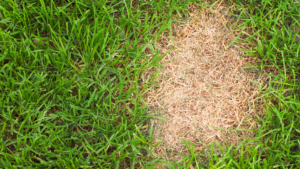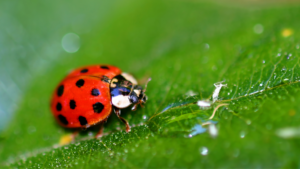A beautiful lawn adds value to your property and brings joy to everyone who sees it. However, keeping your turf lush and green requires attention and care, especially when it comes to dealing with insects. Turf-damaging insects can wreak havoc on your lawn, making it look unhealthy and unattractive. Recognizing the signs of insect damage early can save you a lot of trouble down the line.
Understanding which bugs are causing the damage and knowing how to manage them is crucial. Different insects present unique challenges, and each requires specific treatment methods. Identifying the culprits and taking appropriate actions can help you maintain a thriving lawn year-round.
This article will guide you through identifying common turf-damaging insects and recommend effective management techniques. By learning about different pests and how they affect your lawn, you can take steps to protect your grass and ensure it stays healthy. Let’s dive into the specifics and arm you with the knowledge you need to combat these little invaders.
Common Signs of Turf Damage
Recognizing the signs of turf damage early can help you take action before the problem gets worse. Here are some common indicators that insects may be damaging your lawn:

- Browning Patches: If you notice brown or dead patches in your lawn, it could be a sign of insect activity. These patches may spread quickly if not addressed.
- Thinning Grass: A general thinning of grass can indicate that insects are feeding on the roots or stems of your turf.
- Spongy Grass: Walk on your lawn and see if it feels spongy or loose. This could be a sign that grubs or other insects are eating the roots, leaving the grass with little support.
- Increased Bird Activity: Birds pecking at your lawn more than usual could mean they are hunting for insects hidden in the turf.
Take these signs seriously and investigate further to confirm the presence of pests. Proper identification is the first step in managing the problem effectively.
Identifying Grubs: Larvae of Beetles
Grubs are the larvae of beetles like Japanese beetles, June bugs, and chafers. They live in the soil and feed on grass roots, which can lead to significant turf damage.
Here’s how to identify grubs:
- White C-Shaped Bodies: Grubs are white, with a distinct C-shape when they curl up. They typically have brown heads and range from 1/4 inch to 1 inch in length.
- Damaged Roots: If you pull up a patch of dead turf, you’ll often find grubs eating the roots. The grass will come up easily due to the damaged root system.
- Increased Animal Activity: Animals like raccoons, skunks, and birds often dig up lawns to feast on grubs. If you see these animals frequently, it’s time to check for grub infestation.
Managing grubs involves both preventative and active measures. Applying nematodes, a type of beneficial insect, can help curb grub populations. Chemical treatments, such as grub control products, can also be effective but should be used as directed for safety.
Chinch Bugs: Tiny Pests with Big Impact
Chinch bugs are small but can cause extensive damage to your lawn. These pests suck the sap out of grass blades, leading to yellow patches that eventually turn brown.
How to spot chinch bugs:
- Tiny Black Bugs: Adult chinch bugs are about 1/5 inch long with black bodies and white wings. Nymphs are smaller and reddish with a white stripe across their backs.
- Yellowing Grass: Chinch bug damage starts as small yellow patches that grow larger over time. The affected grass may have a wilted or dried-out appearance.
- Dead Spots Near Pavement: Chinch bugs prefer hot, sunny areas and often start near sidewalks or driveways where the heat is more intense.
To manage chinch bugs, consider using insecticidal soap or other organic treatments. Maintaining a healthy lawn through proper watering and fertilization can also help make your grass less attractive to these pests.
Sod Webworms and Their Lifecycle
Sod webworms are the larvae of small moths and can cause considerable damage to lawns. They feed on grass blades at night, creating small brown patches that can expand if untreated.
Identifying sod webworms:
- Small Moths: Adults are small, beige moths you might see flying over the grass in the evening.
- Silken Tunnels: Look for small silk-lined tunnels in the thatch layer, where the larvae hide during the day.
- Leaf Damage: Sod webworm larvae chew grass blades down to the ground, creating ragged, uneven patches.
To manage sod webworms, you can apply beneficial nematodes or biological insecticides like Bacillus thuringiensis (Bt). Regular mowing and dethatching can also disrupt their lifecycle, reducing their numbers.
Recognizing Armyworms
Armyworms can be a nightmare for any lawn owner. These pests are the larvae of moths and can strip a lawn of its greenery in no time. Recognizing them early can save your turf.
Here’s how to identify armyworms:
- Caterpillar-Like Appearance: Armyworms are usually greenish-brown with stripes running down their bodies. They grow up to 2 inches long.
- Chewed Grass: Unlike some other pests, armyworms eat the entire leaf blade, starting from the edges and moving inward. This results in torn grass blades.
- Clumps of Grass and Dirt: If you see clumps of grass and small piles of dirt, it might be armyworms tunneling through your lawn.
Managing armyworms usually involves applying specialized insecticides. Early morning or late evening is the best time to spot and treat these pests, as they are most active during these periods.
Billbugs: An Overlooked Threat
Billbugs can be sneaky turf destroyers. These insects are beetles, but the biggest damage comes from their larvae, which feed on grass stems and roots.
Identifying billbugs involves these steps:
- Adult Beetles: Adult billbugs have a weevil-like appearance with a snout. They are usually black or brown and about 1/4 inch long.
- Sawdust-Like Droppings: Look for sawdust-like frass at the base of the grass plants. This indicates larvae feeding inside the stems.
- Hollowed Grass Stems: Pull on the grass. If it easily breaks off and has a hollow, straw-like stem, billbug larvae might be the cause.
Control measures include using insecticides that target both adults and larvae. Regular lawn care like mowing and dethatching can help reduce their numbers.
Preventive Measures to Protect Turf
Prevention is the best approach to protect your lawn from insect damage. Implementing good lawn-care practices can make your turf less inviting to pests.
Here are some effective preventive measures:
- Regular Mowing: Keep your grass at the recommended height to reduce hiding places for pests.
- Proper Watering: Watering deeply but less frequently encourages strong root growth, making the grass more resilient.
- Aeration: Aerate your lawn at least once a year to improve soil health and discourage pests from taking root.
By taking these steps, you can create a healthier lawn that is better able to resist insect infestations.
Natural Predators and Beneficial Insects
Leveraging natural predators and beneficial insects is a smart way to keep turf-damaging insects under control. Introducing these helpful critters can reduce the need for chemical treatments.
Some beneficial insects include:

- Ladybugs: These insects feed on aphids, spider mites, and other harmful pests.
- Nematodes: These microscopic worms can target grubs and other larvae living in the soil.
- Predatory Beetles: Ground beetles and rove beetles are effective against many turf-damaging pests.
Encouraging a balanced ecosystem in your lawn can significantly lower the chances of a pest outbreak. Plant diverse flora, reduce pesticide use, and let these natural allies do the work.
Chemical Treatments and Safe Usage
Sometimes, chemical treatments are necessary to manage turf-damaging insects effectively. It’s important to use these chemicals safely and responsibly to protect your lawn and the environment.
Choosing the Right Chemicals:
- Select Targeted Insecticides: Different pests require different insecticides. Read labels carefully to choose products specifically designed for the pests you’re dealing with.
- Environmental Considerations: Opt for chemicals that are less harmful to beneficial insects, pets, and the surrounding environment. Look for products with low toxicity levels.
Safe Application Tips:
- Follow Instructions: Always follow the manufacturer’s instructions on dosage and application methods. Applying too much can harm your lawn, while too little can be ineffective.
- Use Protective Gear: Wear gloves, masks, and eye protection to avoid contact with chemicals. Ensure children and pets are kept away from treated areas until it’s safe.
- Avoid Water Contamination: Apply chemicals when there’s no rain in the forecast to prevent runoff into water bodies. Don’t apply near wells, streams, or ponds.
Integrated Pest Management Strategies
Integrated Pest Management (IPM) combines biological, cultural, physical, and chemical tactics to manage pests. Using IPM helps reduce the reliance on chemical treatments by focusing on long-term prevention.
Key Components of IPM:
- Biological Control: Introduce natural predators like ladybugs, nematodes, and birds that feed on turf-damaging insects.
- Cultural Practices: Improve lawn care practices to make your turf less attractive to pests. This includes proper mowing, watering, and fertilizing.
- Physical Methods: Use barriers, traps, or manual removal to control pest populations. For example, physically removing grubs from the soil can reduce their numbers significantly.
- Chemical Use as Last Resort: Apply chemical treatments only when necessary and as part of a broader plan. Use targeted insecticides to minimize the impact on beneficial insects.
Seasonal Tips for Turf Maintenance
Different seasons bring different challenges for turf maintenance. Adapting your care routine to the seasons can help keep your lawn healthy and pest-free.
Spring Tips:
- Inspect and Repair: Check your lawn for winter damage and repair bare or thin spots by overseeding.
- Aerate and Dethatch: Aerate the soil to reduce compaction and dethatch to remove dead grass and debris.
- Fertilize and Water: Apply a balanced fertilizer and water regularly to promote strong growth.
Summer Tips:
- Mow High: Keep your grass a bit longer to shade the soil and preserve moisture, which helps prevent pest invasions.
- Water Deeply: Water deeply but infrequently to encourage deep root growth.
- Monitor for Pests: Regularly inspect your lawn for signs of insect activity and take action if needed.
Fall Tips:
- Overseed: Add new seed to maintain a thick lawn that can outcompete weeds and resist pests.
- Fertilize: Apply a fall fertilizer to help your grass store nutrients for the winter.
- Clean Up: Rake leaves and remove debris to prevent mold and pests from taking hold over the winter.
When to Call in Professional Help
Sometimes, despite your best efforts, professional help may be necessary to handle severe pest infestations or persistent turf problems.
Signs You Need Professional Assistance:
- Severe Infestation: If you notice extensive damage and can’t control the pest population, it’s time to seek expert help.
- Recurring Issues: If pests keep returning despite treatments, professionals can identify and address underlying issues you might miss.
- Specialized Treatments: Certain pests require specific treatments that only professionals can safely apply.
Conclusion
Keeping your turf healthy and pest-free involves vigilance and the right strategies. From using chemical treatments safely to adopting Integrated Pest Management practices, taking a comprehensive approach is key to maintaining a vibrant lawn. Tailoring your lawn care routine to the seasons ensures your turf stays robust and resilient year-round. And when challenges become too tough to handle on your own, professional help is always available.
Ready to protect your lawn from damaging pests effectively? Contact TDI Services for expert advice and solutions tailored to your lawn’s needs. Let us help you achieve a thriving, pest-free lawn today.
